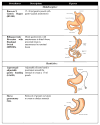Bariatric Surgery: Pathophysiology and Outcomes
- PMID: 27823611
- PMCID: PMC9075538
- DOI: 10.1016/j.ecl.2016.06.011
Bariatric Surgery: Pathophysiology and Outcomes
Abstract
Diabetes mellitus and obesity are closely interrelated and pose a major burden on health care in terms of morbidity and mortality. Weight loss has favorable metabolic benefits for glycemic control and improvement of metabolic syndrome. Bariatric surgery (BS) is the most effective treatment for weight loss with durable results as compared to lifestyle modification. BS procedures have been associated with significant reduction in abdominal obesity, metabolic syndrome components, and glycemic control requiring fewer medications. Long-term risks of surgery include nutritional deficiencies, osteoporosis, bone fractures, and hyperinsulinemic hypoglycemia, which need to be carefully balanced with metabolic benefits for individual patients.
Keywords: Bariatric surgery; Metabolic effects; Obesity; Type 2 diabetes; Weight loss.
Copyright © 2016 Elsevier Inc. All rights reserved.
Figures





References
-
- Centers for Disease Control and Prevention. Death and Mortality. NCHS FastStats Web site. http://www.cdc.gov/nchs/fastats/deaths.htm.
-
- Gerteis J, Izrael D, Deitz D, et al. Multiple Chronic Conditions Chartbook. Agency for Healthcare Research and Quality; 2014. AHRQ Publications No, Q14–0038.
-
- National Diabetes Statistics Report. 2014.
Publication types
MeSH terms
Substances
Grants and funding
LinkOut - more resources
Full Text Sources
Other Literature Sources
Medical

